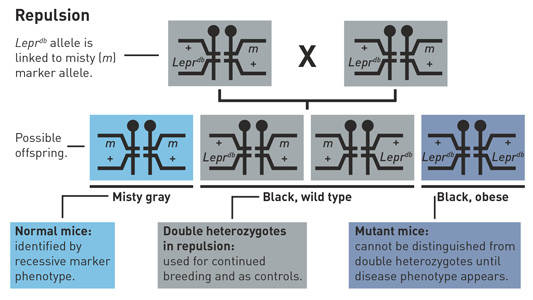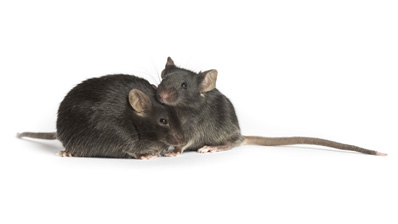Who would have thought that a black mouse with a chance mutation would one day become one of the most used mice in diabetes and obesity research? Such is the case with BKS.Cg-Dock7m +/+ Leprdb/J (000642), a JAX® Mice strain harboring the spontaneous diabetes mutation (db) in the leptin receptor (Lepr) gene. The JAX® Mice Database lists more than 600 journal articles with this mouse as a main character.
Homozygous Leprdb mutant mice play a key role in many research areas, including type 2 diabetes, obesity, endocrine defects, fertility, metabolism, cardiovascular disease, thermoregulation, impaired wound healing and diabetic neuropathy (see phenotypes and associated references below). The mouse’s popularity as a research tool has resulted in its extensive characterization.
Because homozygous Leprdb mutants are sterile, the strain must be maintained by mating heterozygotes to heterozygotes. Prior to 1996, the db mutation in this strain was not yet cloned and characterized, so no molecular assay was available to distinguish heterozygous from wild-type mice. This challenge was alleviated by taking advantage of the recessive coat color mutation, misty, which is closely linked to the Lepr locus on Chromosome four.
The misty gene has since been cloned and its nomenclature updated to Dock7m. It was incorporated into the BKS- Leprdb mutant, creating a strain in which the misty and Leprdb alleles are in repulsion (see figure below). Mice homozygous for the Dock7m mutation and wild-type for the db mutation are misty colored and lean (photo, lower right); mice heterozygous for the db mutation are black and lean (second image below); mice homozygous for the db mutation are black and obese (not shown). When maintaining a colony of BKS.Cg-Dock7m +/+ Leprdb/J mice, the combination of coat color and early development of the obese phenotype makes identification of genotypes simple, effective, time-saving and free (talk about cost-effective!).

As researchers delved deeper into metabolic pathways, they often needed to genetically modify the BKS.Cg-Dock7m +/+ Leprdb/J strain. They also needed more than a visual technique for genotyping Dock7m mutants. So, necessity being the mother of invention, a molecular assay was developed after Dr. Jeff Friedman fully characterized the db/db mutation. The assay consists of PCR-amplification of the mutated region followed by a restriction digest. A complete protocol is freely available from the strain datasheet of strain 000642 on the JAX website.
Some notable features of BKS.Cg-Dock7m +/+ Leprdb/J include the following:
- Diabetes phenotypes: hyperinsulinemia, insulin resistance, hyperglycemia, glucose intolerance, abnormal islet morphology (Hummel et al. 1966. Science 153:1127-8; Uchida et al. 2005. Nat Med11:175-82; Yamauchi et al. 2007. Nat Med 13: 332-9); peripheral neuropathy (Raizada et al. 1980. J Biol Chem 255:9149-55; Robertson and Smith. 1980. Diabetes 29:60-7)
 Failure of exogenous insulin to control blood glucose levels (Robertson and Smith. 1980. Diabetes29:60-7)
Failure of exogenous insulin to control blood glucose levels (Robertson and Smith. 1980. Diabetes29:60-7)- Renal defects: increased creatinine clearance, decreased albumin secretion (Wendt et al. 2003.Am J Pathol 162:1123-37)
- Obese by three to four weeks of age (Hummel et al. 1966. Science 153:1127-8; Greer. 2006. Am J Physiol Heart Circ Physiol 290 H146-53)
- Abnormal lipid levels: high HDL, LDL, VLDL, and triglyceride levels (Nishina et al. 1994. Metabolism43:549-53)
- Polyphagic (Uchida et al. 2005. Nat Med 11:175-82)
- Severe liver steatosis (Kanda et al. 2006. J Clin Invest 116:1494-505)
- Low body temperature (Trayhurn. 1979. Pflugers Arch 380:227-32; Uchida et al. 2005. Nat Med11:175-82)
- Increased gluconeogenic enzyme activity (Leiter et al. 1979. In Vitro 15:507-21)
- Cardiovascular defects (Greer et al. 2006. Am J Physiol Heart Circ Physiol 290:H146-53; How et al.Diabetes 55:466-73)
- Reproductive defects: sterile, low uterine and ovarian weights, low ovarian hormone production and hypercytolipidemia in follicular granulosa and endometrial epithelial tissue layers (Garris. 2004.Tissue Cell 36:19-28)
- Increased metabolic efficiency (Trayhurn. 1979. Pflugers Arch 380:227-32)
- Delayed wound healing (Werner et al. 1994. J Invest Dermatol 103:469-73; Brem et al. 2007. Exp Gerontol 42:523-31)
- Diabetic neuropathy (Robertson. 1980. Diabetes 29(1):60-7. Norido. 1984. Exp Neurol 83(2):221-32)
A number of strains are useful for studying type 2 diabetes. Each has a unique phenotype. To make choosing the right strain easier, we’ve developed a website that contains many resources that may help you study type 2 diabetes and obesity. This site includes a helpful table that compares the major diabetes and obesity phenotypes of BKS.Cg-Dock7m +/+ Leprdb/J (000642) to six other commonly used mouse models of human type 2 diabetes. Bulleted summary descriptions of these and newly developed models are also available. These descriptions provide “at a glance” information about key strains. Below the descriptions, several strains have links to phenotypic data on weight gain and fed blood glucose over time. This information allows you to see how these strains differ as disease progresses.
To find out more about the BKS.Cg-Dock7m +/+ Leprdb/J mouse, check out the JAX® Mice Database (000642), or the Mouse Phenome Database. Maybe you’ll decide that this is the mouse you’ve been looking for, or maybe you’ll find another JAX® Mice strain that is more appropriate for your research.